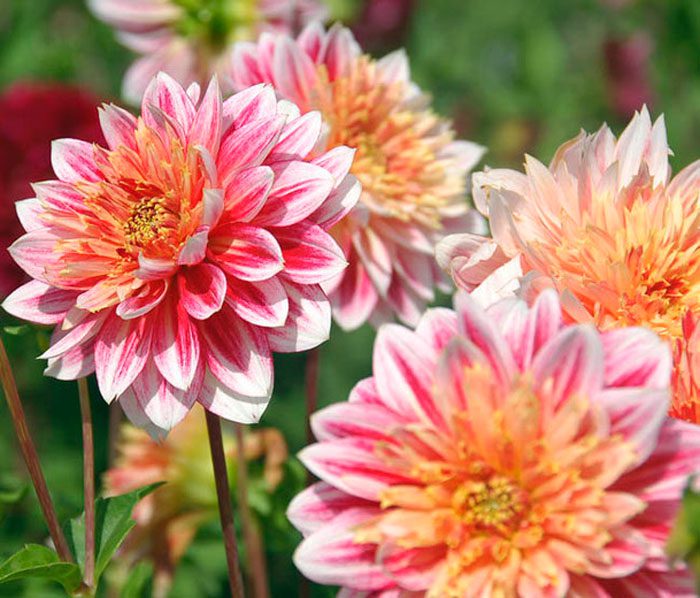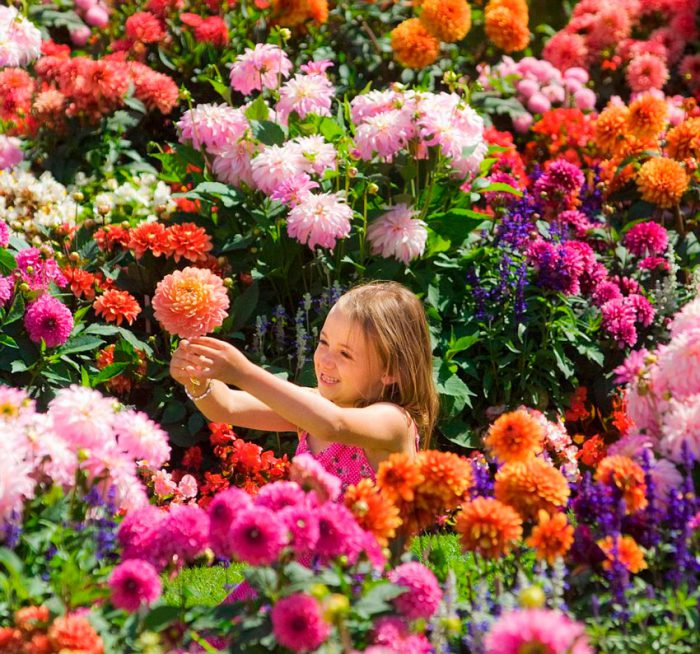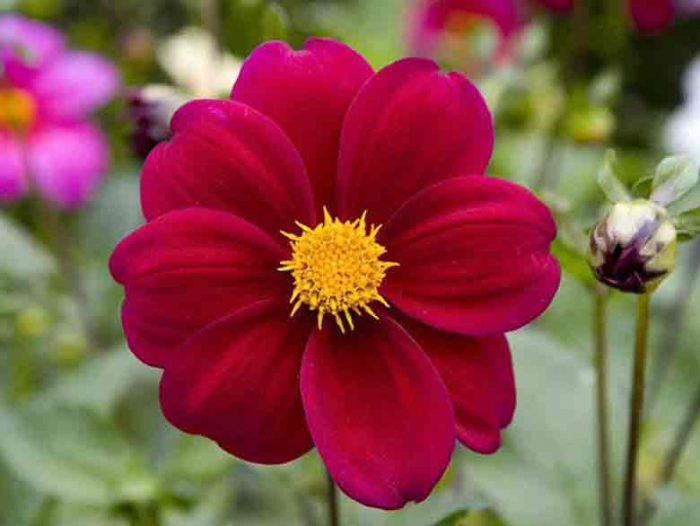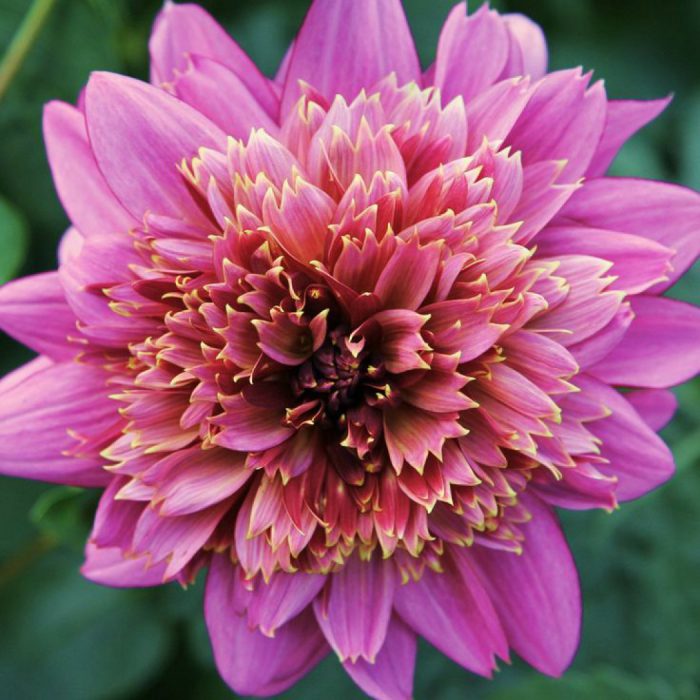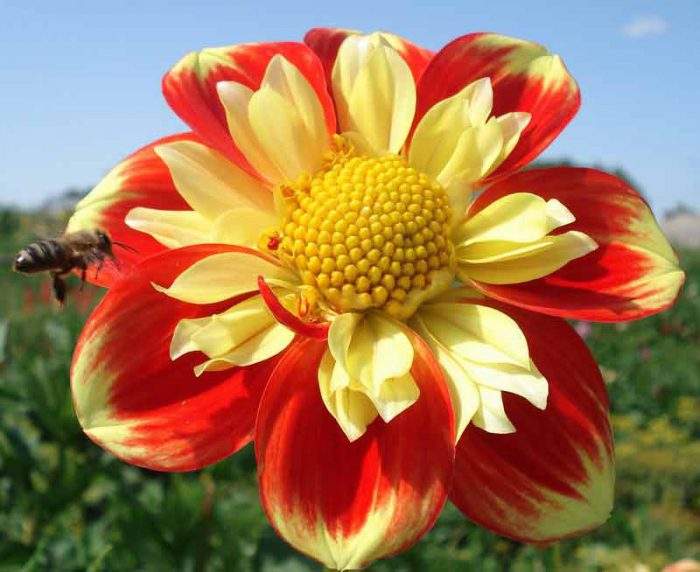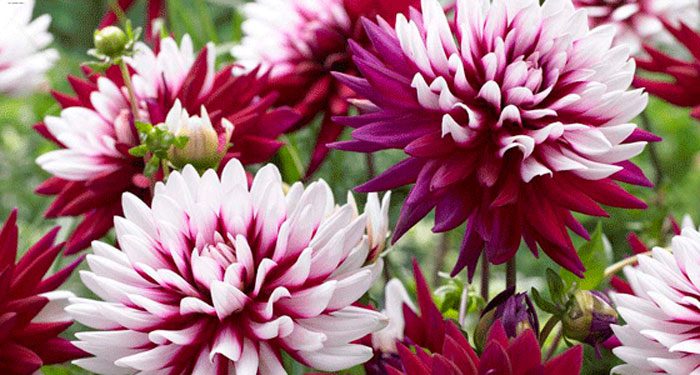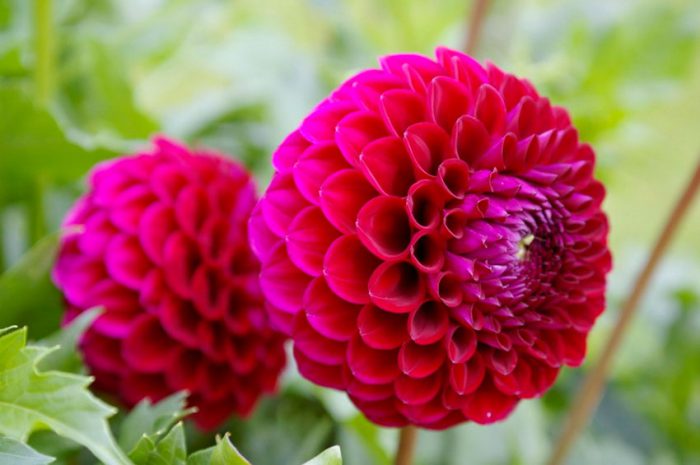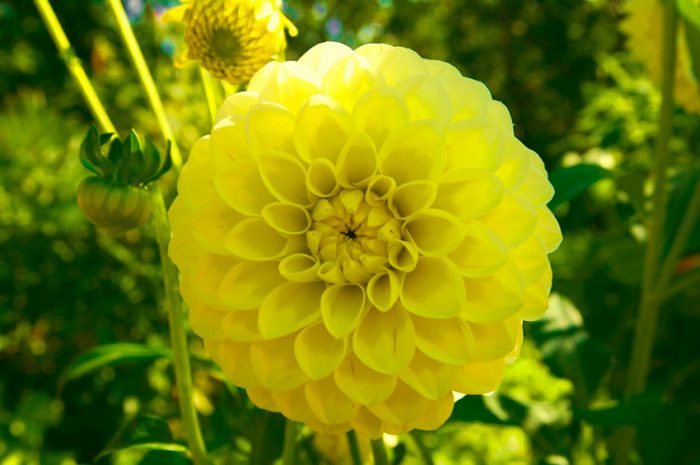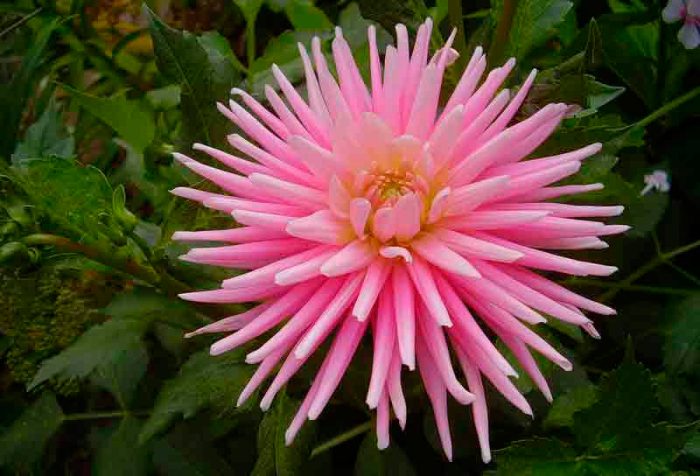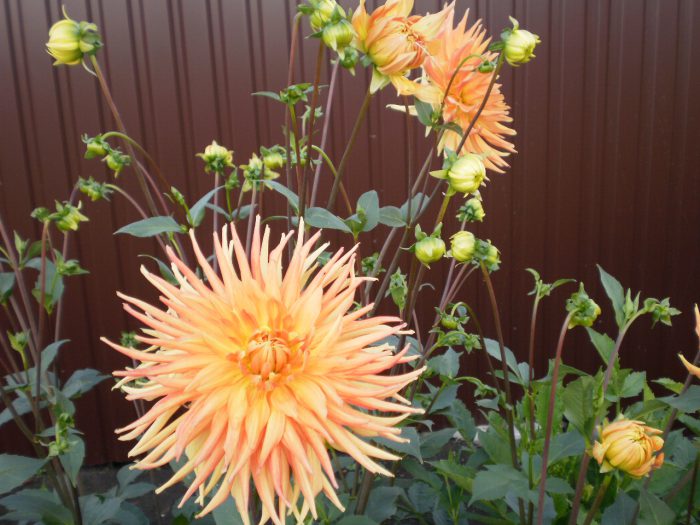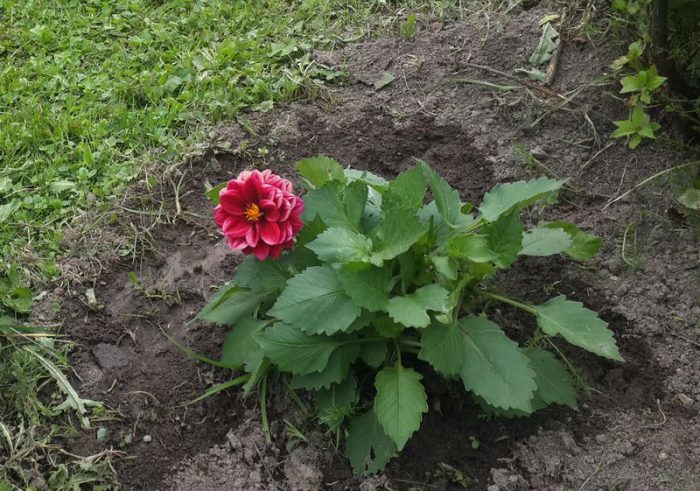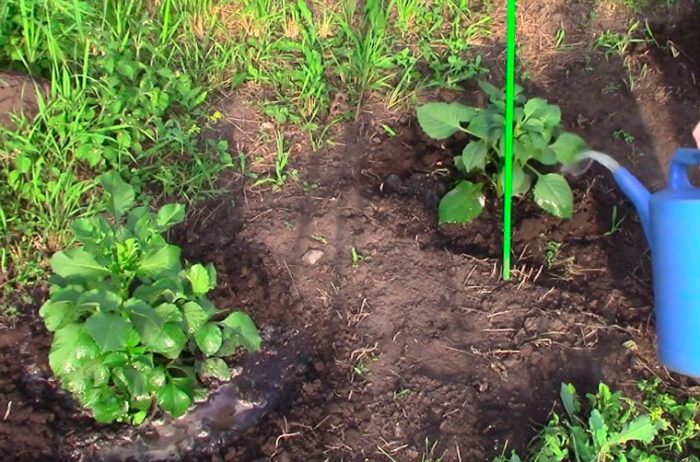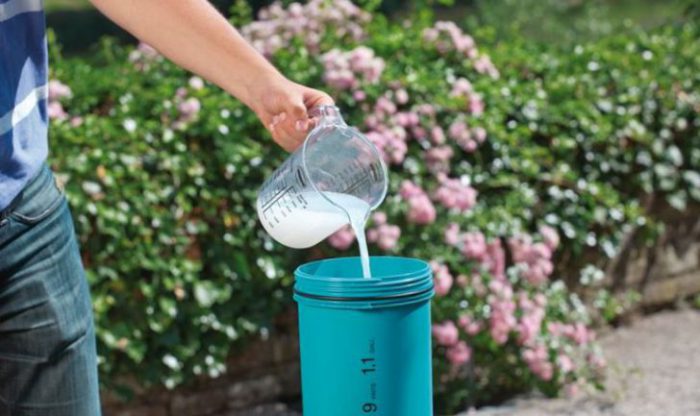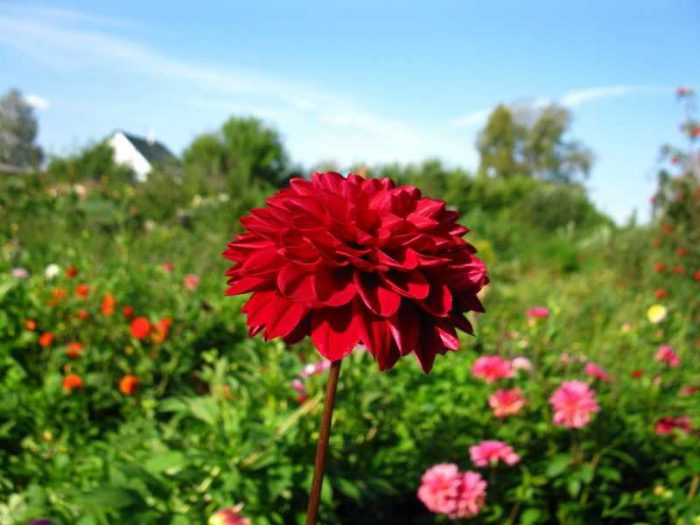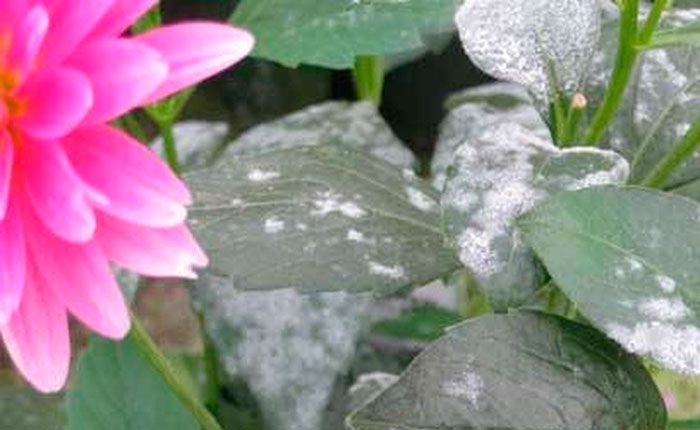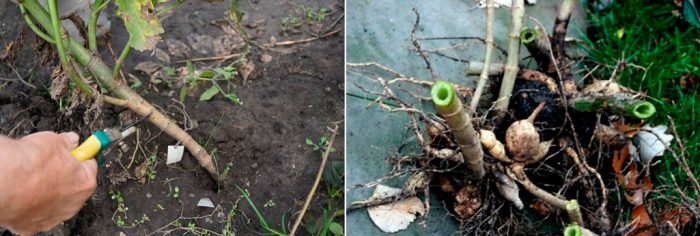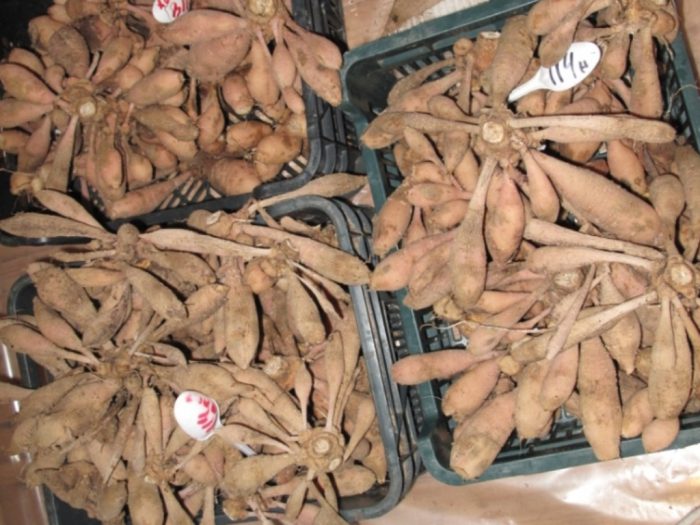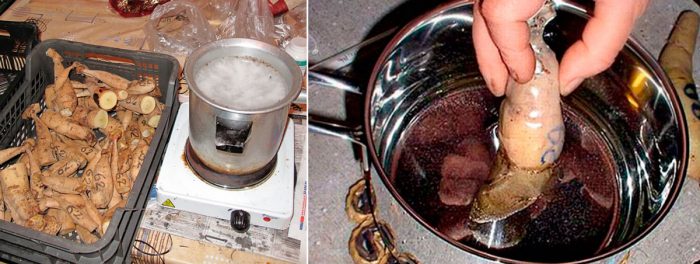Dahlias (Dahlia) are directly related to the Aster family. This plant is one of the most spectacular and long-flowering flowers that are grown in the garden. Dahlias have a fairly wide palette of colors, and flowers can also have a wide variety of shapes. Their flowering is quite long, which lasts from mid-summer until the first autumn frosts, and this is the most important advantage of dahlias. They came to European countries only at the end of the 18th century from Mexico. Dahlia was named this way only in 1803 by the botanist K. Wildenau. He named this flower in honor of the St. Petersburg resident academician I. Georgi, who was a famous ethnographer, botanist and geographer. There are about 13 types of dahlias, but there are about 15 thousand varieties.
Content
Growing features
The varieties, shapes and colors of such plants are very different. They can be used to decorate both a flower bed and a border line. And if desired, you can use it as a single or even indoor flower. Such beautiful flowers are distinguished by their undemanding and not capriciousness. Choosing a good planting site with suitable soil and feeding and watering the plant correctly will help it grow very quickly and bloom profusely. Mid-spring is the best time to buy dahlia tubers. Note that they should be strong, fleshy, and have short but well-defined sprouts. If the tuber is soft or dryish, then it is not recommended to purchase it.
Main varieties with photos
The classification of these plants is associated with the structure, as well as the shape of the flower itself. At the moment, there are 12 classes of dahlia. However, more and more new classes appear gradually and this is associated with the formation of new varieties. Below are the varieties that are most popular:
Simple
They have one row of petals, the diameter of the flowers is 10 centimeters. The height of the bush, as a rule, does not exceed 45-60 centimeters. The main varieties are: Princess Marie Jose pink, Yellow Hammer - yellow, and Orangeade - orange-red.
Anemone
There are 1 or more rows of marginal petals.In the middle, they are tubular, elongated. The diameter of the inflorescences does not exceed 10 centimeters, and the height of the bush can be equal to 60–90 centimeters. The main varieties are lilac-yellow Lucy, bronze Vera Higgins and red Comet.
Collar
The diameter of the flowers is about 10 centimeters, and the height of the bush can reach 75-120 centimeters. There is 1 marginal outer row of petals, directly along its top there is another row of twisted and short petals of a different color, which looks similar to a collar. The main varieties are gold with scarlet La Gioconda, Chimborazo cream with reddish, Claire de Luna cream with yellowish.
Peony
The diameter of the flowers is 12-15 centimeters. Marginal flat petals are located in 2 or more rows, and tubular petals are located in the central part. The height of the bush is 75-120 centimeters. The main varieties are Symphonia crimson red and lilac Fascination.
Decorative
The diameter of the double flowers varies from 8 to 25 centimeters, and the height of the bush can reach 60 centimeters. Main varieties: small orange David Howard, large yellow Thames Valley, and very large purple Jocondo.
Spherical
Round, rarely slightly flattened double flowers in diameter can reach 8-15 centimeters. The height of the bush is 90-120 centimeters. The main varieties are the peach-red Crichton Honey, the reddish Doreen Hayes and the yellow Esmonde.
Pompom
The diameter of the spherical flowers is 5 centimeters or more. Rolled edge petals have a round or blunt end. The height of the bush is 90-120 centimeters. The main varieties are Hallmark lavender, light purple Willo's Violet and pinkish Noreen.
Cactus
The diameter of the double flowers can be equal to 8–25 centimeters or even more, and the height of the bush is from 90 to 150 centimeters. The marginal petals are narrow, pointed and coiled. Main varieties: rather large reddish Visit, very large pink Danny, miniature yellow Pirouette, small red Doris Day.
Semi-cactus
The diameter of the double flowers varies from 8 to 25 centimeters, and the bush in height can reach from 90 to 150 centimeters. The marginal petals are folded from the middle to the tips. The main varieties: very small Yellow Moods in yellow, small White Swallow in white, rather large yellows Nantenan and medium-sized orange Autumn Fire.
Nymphae
Outwardly, double flowers are similar to water lilies, they have the correct shape and are distinguished by their grace. Their diameter can vary from 7 to 20 centimeters, and the height of the bush reaches 70–130 centimeters. The main varieties are light pink Geri Hawk, pure white Genette and lilac Brushstrokes.
Mixed
This includes those varieties that are not similar to those described above.
However, such flowers have not only varied flower shapes, they also have a very wide palette of colors. So, you can even meet a black dahlia, or rather a black-red color. Such a plant has accumulated many special pigments - anthocyanins. However, all breeders in the world strive to create a blue dahlia. However, unfortunately, they have not yet succeeded, but the hope of someday seeing this miracle remains.


Watch this video on YouTube
How to grow dahlias
Growing dahlias is easy enough, but they require special care, which is quite laborious. So, in the autumn, it will be necessary to dig up the tubers, as well as provide them with the most comfortable storage. However, in case you do not wish to put a lot of effort into growing such flowers, then seeds can be used for planting. Annuals also have a very spectacular appearance, and there is a fairly large selection of different varieties: Coltness Hybrids, abundantly blooming with non-double flowers, of various colors, the height of the bush is no more than 50 centimeters; Redskin possesses bronze foliage; Rigoletto has small double flowers; early flowering Figaro and others. It is recommended to sow the purchased seeds in open soil only in the second half of May, but in this case they will be seen blooming only at the end of summer. In order to bring the moment of flowering of annual dahlias closer, it is recommended to grow them through seedlings.
First, the seeds need to germinate.To do this, you need a plastic container or greenhouse, which should be filled with calcined sand. So, dahlia seeds are distributed over the surface, and a thin layer of sand is poured over them, everything is thoroughly moistened from a spray bottle and covered with a film on top. Germination will take about 10 days, while the temperature should be at least 25-27 degrees. After that, the sprouts that appear dive into individual containers. The soil mixture must necessarily absorb water well and be loose. Such soil can be purchased in a store or prepared on its own by combining leafy soil, sand and peat, taken in a 2: 1: 1 ratio. Before picking for three days, the soil mixture must be processed, for this it is spilled with a solution of manganese potassium, which should be hot (about 70 degrees) and have a dark pink color. Diving plants need to be watered as the soil dries out. Seedlings can be transplanted into open soil in mid-May.
Dahlia planting
Seat selection
Before you start planting dahlias directly, you need to choose the most suitable place for them. Such a plant reacts extremely negatively to a draft. However, it will be able to grow and develop normally only in a sunny and ventilated area, which, moreover, will be protected from gusts of wind. Suitable land should be well-drained, water-permeable, and nutrient-dense. The acidity of the soil for such a plant is not too important, but it is best if it is neutral or slightly acidic. In overly acidic soil, the pH of which is 5–4, it is recommended to add slaked lime. And in the case when the pH exceeds 8.5, peat is introduced into the ground.
When digging in the ground in the autumn, you can add compost, as well as humus at the rate of 3-5 kilograms per 1 square meter. In the spring, before planting dahlias, a small amount of wood ash, as well as mature compost (only not deciduous), must be distributed in an even layer over the surface of the soil, then everything must be hardened with a rake. In order for the plants to hurt less and not degenerate, experienced flower growers advise that they should be planted in a new area every year. At the same time, the place where the dahlias grew must take a break from these flowers for at least 3 years. Also, for planting these plants, it is not recommended to use the soil on which asters or flowers susceptible to fungal diseases were previously grown.
How to prepare tubers for planting
Tuber preparation should be done in April. So, they need to remove dried roots, as well as damaged areas. Then it is necessary to process the cut points with brilliant green. After that, the prepared tubers must be planted in a pot filled with fertile soil or peat. They need to be planted so that the upper part rises above the surface of the substrate by 2-3 centimeters. For a couple of weeks, the container should be placed in a well-lit and warm (at least 18 degrees) place. After the buds appear, it is necessary to divide the tubers into parts. It should be remembered that each section must have a bud with a root collar. It happens that 5 divisions come out of 1 tuber. Delenkas need to be planted again and raised for some time. After that, they cut off the side shoots, which are at least 10 centimeters high, and planted in open ground. Those shoots that have been cut should be planted in the substrate as cuttings and removed in a dark place. Give them good watering. Rooted cuttings can be transplanted into open ground. These procedures will help to multiply dahlias quickly enough, as well as prevent their degeneration. If it is not necessary, the division of tubers can be omitted.
Planting dahlias in open ground
Dahlias can be planted outside only after warm weather is established and the soil warms up enough.Most often this time falls on the last days of May, first June. The size of the hole should exceed the size of the tuber itself, together with the root system, exactly 3 times (40X40X40). So, after the tuber is in the hole, about 5–7 centimeters should remain. At the bottom of the prepared hole, make a layer of rotted manure or compost, pour a layer of soil on top so as not to burn the root system. Then place the sprouted tuber in the hole and sprinkle it with the required amount of soil, but so that a few centimeters of the plant stem are above the ground surface. In the event that tall dahlias are planted, a reliable support is immediately established around them. When the plant is planted, it must be well watered with cold water, and the surface of the soil should be sprinkled with mulch consisting of sawdust or small bark, which must be mixed with compost or peat. The mulch layer should be about 5 centimeters.
Dahlia care
How to water properly
A layer of mulch on the surface of the soil will protect against slugs and excessive rapid drying of the soil, and will also help get rid of the need for weeding and loosening the soil. Watering should be abundant 1 or 2 times every 7 days (not on rainy days), but make sure that the soil is not waterlogged, because in this case, rot can appear on the root system quickly enough. To reduce the amount of watering on hot days, you need to spud the dahlias. Before watering the plant, it is necessary to shake off the soil with which it is covered. Then water and sprinkle the dahlia again.
Top dressing
During the growing season, fertilizing is needed for such flowers 2 times a month, while it is necessary to use both mineral and organic fertilizers, and they must be applied to the soil one by one. So, as organic fertilizers, you can use an infusion of mullein (1:10) or poultry manure (1:20), as well as ammonium nitrate, while 15 grams is taken per 1 square meter. When the first buds appear, they are fed with superphosphate and potassium fertilizers, while 30 g of the substance is taken per 10 liters of water (the amount is calculated for feeding 8 plants).
Support
Since the stem of such a flower is hollow, it is quite fragile and can be damaged during bad weather. In this regard, it must be tied to a reliable support. In the event that the stem does break, it is recommended to try a splint. To do this, take a strong twig and attach it to the damaged area, fix it. Support the stem so it does not tilt. If you do this in a timely manner and provide the dahlia with proper care, then even on the damaged stem, beautiful flowers can bloom.
Pruning
In the event that there is a desire to get larger and more spectacular flowers, it is recommended to resort to pruning. So, you need to leave only 3 stems. Otherwise, the flowers will be small and not very showy. On each of the peduncles, you need to remove the extra buds, leaving 1 or 2. Flowers that have begun to wilt need to be cut off, because they take a lot of energy from the plant. During the whole season, in tall varieties, it is recommended to cut off the growing lateral shoots, which can be used as cuttings. In low-growing varieties (for example: cactus, pompom), as well as in those bushes that grow singly, side shoots can be left if desired.
Pests
Slugs can settle on the stems of dahlia, and earwigs can settle on the buds. If pests have been noticed, then it is necessary to carry out treatment with a decoction of celandine or wormwood once every 7 days, and it is better to do this in the evening. On hot days, it is necessary to carry out treatment with insecticidal preparations against aphids, caterpillars, thrips, as well as ticks. Aphids settle on this flower most often. In order to get rid of it, you can treat the bushes with soapy water.
Dahlia tubers harvesting
You need to dig up the tubers after the onset of the first frost. All the leaves and shoulder straps are cut off from them, and the shoots are shortened to 5-10 centimeters. There are gardeners who cut the stems a few days before harvesting tubers. But if liquid gets on the sections, then the base of the stem may begin to rot. In this regard, after cutting, the plant must be covered with aluminum foil. It should be remembered that the necks of the tubers are very fragile, and therefore their experts advise you to start digging in the morning in dry sunny weather. By the evening, the neck will have time to dry out and become stronger. It is also much easier to remove the remaining soil from dried tubers.
You need to dig out the tubers correctly. Dig in the dahlia on 4 sides, while you need to retreat from the stem by 30 centimeters. This will cut the long roots. Then the pitchfork must be carefully brought under the earthen ball and pushed to the surface. Remove soil and spread out tubers to dry. The dug tubers must be rinsed with running water (from a hose) to remove soil residues, which may contain pathogens. They need to be removed on time, since if warming occurs in the fall, then dormant buds may wake up, and this can destroy them.
How to store dahlias in winter
Well-dried tubers should be put in storage so that rot does not appear on them. But they should not be overdried, because in spring they will sprout weak. All mechanical damage must be cut off, and these places must be treated with charcoal. To preserve the integrity of the root necks, they are sprinkled with chalk or ash.
It is necessary to store the tubers in a ventilated area, while the humidity should be 60-70 percent, and the temperature should be from 3 to 5 degrees. You can use a dry basement, but if vegetables are also stored there, this will cause higher air humidity, which will increase the risk of rot and fungal diseases. It is recommended to put the tubers in a box, at the bottom of which a layer of peat is poured, and on top they need to be filled with them. Also, sand or coniferous sawdust is suitable for these purposes. When the tubers dry out and wither, it is recommended to moisten the substrate quite a bit. In the absence of ventilation, you will need to turn on the fan 3 times in 7 days for 30 minutes.
In an apartment, planting material should be stored in the coldest place. As a rule, they are placed in a box and placed next to the balcony. Tubers can be placed in polyethylene bags and filled with sand, sawdust or dried peat, and then tied well. You can wrap each tuber in a newspaper sheet and put them in a plastic bag. And then they are placed in a cardboard box and put away in a fairly cool place, for example, on a glazed loggia. But remember that severe frosts can destroy the tubers.
Tubers are very poorly stored in warmth and high humidity. But paraffin, which should cover the tubers, can correct this situation. You need to put paraffin in a water bath and wait until it melts. Immerse the tuber in it for 1 second, take it out, wait a few seconds and dip it back into the resulting liquid. Such tubers should be folded into a cellophane bag and sand, dry peat or sawdust should be added there. Tie tight. Before planting such tubers, rub them a little, which allows the film to crack.
In winter, carry out systematic inspections of the planting material. When rot appears, it must be cut out and sprinkled with hardwood charcoal or treated with brilliant green.
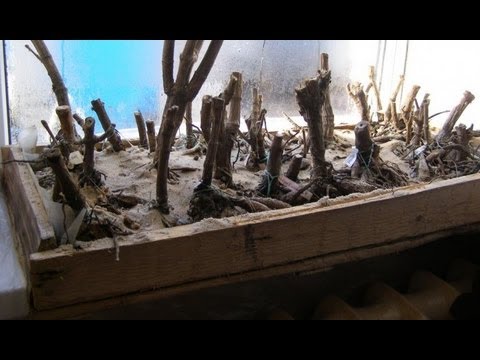

Watch this video on YouTube

